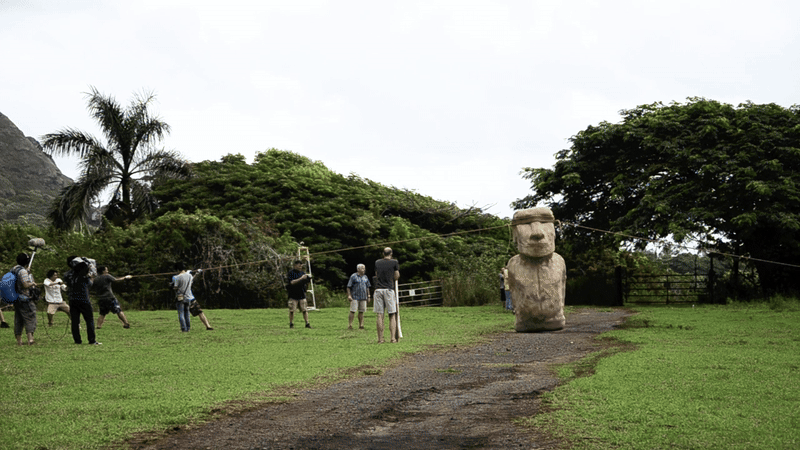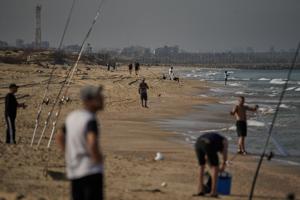Science
Easter Island Moai Statues Could ‘Walk’ with Simple Physics

Easter Island’s iconic moai statues could have been transported by a small group of people using basic principles of physics, according to a new study published in the November 2025 issue of the Journal of Archaeological Science. Researchers found that with the right combination of long ropes and pendulum dynamics, as few as 15 individuals could facilitate the movement of these massive statues, which can weigh several tons.
The debate surrounding how the Indigenous people of Easter Island, known as Rapa Nui, managed to move these colossal figures has persisted for years. Previously discarded, incomplete moai statues revealed crucial design elements that contributed to their mobility. The study’s authors noted that the statues were originally crafted with a low center of mass and a slight forward lean, optimizing them for transport before they were carved into their final ceremonial forms.
The research team, led by anthropologists Carl Lipo and Terry Hunt, recreated the moai virtually to investigate how they could be moved efficiently. Their findings indicated that, with the aid of three ropes, a small team of between five and 60 people could initiate a walking motion, allowing the statues to take steps averaging 35 inches (89 centimeters) as they traversed the landscape of Easter Island.
Innovative Approaches to Ancient Transportation
The traditional perspective on the transportation of the moai suggested that vast resources and large groups were necessary for such monumental tasks. This study challenges that notion. “What we found is the fact that statues were moved with very small numbers of people in an amazingly ingenious way,” Lipo explained to Live Science. He emphasized that the method seemed intuitive once demonstrated.
The research also built upon a televised experiment conducted in 2012, where a team moved a scaled replica of a moai weighing 4.8 tons (4.4 metric tons) over a distance of 328 feet (100 meters) in just 40 minutes. Lipo acknowledged that they had initially overlooked the physics behind the movement during that experiment.
To fill this gap, Lipo and Hunt developed 3D models of 62 moai located along ancient pathways, referred to as “road moai.” These models revealed that the statues had a forward lean of approximately six to 15 degrees, which shifted their center of mass. This design allowed for stability when the moai were rocked side to side, mimicking a walking motion.
The absence of eye sockets in these road moai, contrasted with their presence in finished statues, suggests that the final detailing occurred only after the moai reached their intended locations.
Efficient Movement and Future Implications
The researchers modeled the physics involved in the moai’s movement, calculating the workforce required and estimating travel times based on the lengths of ropes used, which ranged from 20 to 30 meters. They concluded that between 15 and 60 individuals would be needed to initiate movement, while only five to 25 would be necessary to maintain it, highlighting the efficiency of this method.
The study reported that the moai could potentially “walk” at an average speed of 1,000 feet (310 meters) per hour. A typical moai would require about 11,000 steps to complete a journey of 6.2 miles (10 kilometers) from its quarry to its ceremonial site.
Critics of the study, such as Sue Hamilton, an archaeologist at University College London, acknowledged the research as a significant contribution but cautioned that it remains one of many interpretations regarding how the Rapa Nui moved the moai. Hamilton noted that the data might support various theories, including the possibility that different engineering techniques were employed for different ceremonial purposes.
While the study demonstrates the technical feasibility of moving the moai upright, it does not conclusively prove that this method was historically employed. Lipo and Hunt argue that opponents of the “walking moai” theory have yet to present plausible alternatives that account for the existing evidence.
This research not only sheds light on the ingenuity of the Rapa Nui people but also opens new avenues for understanding the social and logistical dynamics of ancient communities in the Pacific. As discussions around this topic continue, the findings may redefine our perception of how these monumental statues were crafted and moved across Easter Island’s rugged terrain.
-

 Health4 days ago
Health4 days agoRare Brain Condition Discovered More Common in New Mexico
-

 Politics5 days ago
Politics5 days agoPrince Andrew Steps Back from Royal Duties Following Epstein Memoir
-

 Sports6 days ago
Sports6 days agoMLS Decision Day 2025: Playoff Spots on the Line as Teams Clash
-

 World5 days ago
World5 days agoYoung Driver Dies in Collision with Box Truck in El Cajon
-

 Science6 days ago
Science6 days agoIdaho State University Launches Haunted Science Laboratory on Oct. 25
-

 Lifestyle6 days ago
Lifestyle6 days agoKent Hamilton Named Southeastern Farmer of the Year at Expo
-

 Health5 days ago
Health5 days agoRemembering Mary Ingleby: A Life of Love, Teaching, and Music
-

 Business5 days ago
Business5 days agoFirst National Bank of Groton’s Quiet Period Ends October 21
-

 Entertainment5 days ago
Entertainment5 days agoTrump Commutes George Santos’ Sentence, Sparks Controversy
-

 Politics6 days ago
Politics6 days agoNavy Veteran Max Quattromani Launches Campaign for Assessor Seat
-

 Sports5 days ago
Sports5 days agoSaquon Barkley Reacts to James Franklin’s Dismissal from Penn State
-

 World6 days ago
World6 days agoHamas to Return Additional Hostage Remains on Friday









